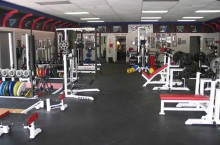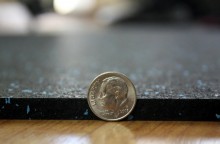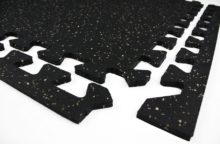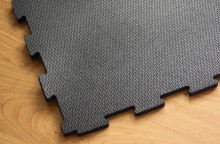Rubber Tiles for Shop Flooring?
Article - August 28, 2012
Out of all the decisions to make and details to research, nothing has caused me to walk in mental circles more than the floor. One of the great advantages of having this blog is the fact that I can ask for opinions, and receive hundreds of responses. One the great disadvantages of this blog is the fact that I can ask for opinions, and I receive hundreds of responses! With so many varied opinions, each reflecting the individual’s preferences and needs, I often find myself more confused than I was before. So I decided that titling this article, “Shop Flooring Options” would probably be a bad idea. Instead, I’m going to focus on the one flooring solution that I am leaning heavily toward, in hopes that your responses will push me one way or the other.
And before anyone even asks the question, “Why not go for xyz type flooring solution?”, let me say that I am not 100% decided on anything at this point. But what I really want to focus on right now are the advantages and disadvantages of a dense rubber shop floor.
Durability
 I am currently waiting on samples to arrive so I can inspect this stuff first hand. The fact that it is made from recycled tires and each tile weighs in a 12 lbs is a pretty good indication that this is some seriously dense rubber. This is pretty much the same stuff you might find in a gym, getting smashed by dumbbells and experience lots of foot traffic. If it can hold up in a gym environment, I feel confident it will hold up in my shop. My only reservation is how well a heavy tool will roll across this surface. I don’t move my tools often, but if I need to scoot my planer or jointer one way or another, will this rubber have too much give? Hopefully the samples will give me some additional insight on this.
I am currently waiting on samples to arrive so I can inspect this stuff first hand. The fact that it is made from recycled tires and each tile weighs in a 12 lbs is a pretty good indication that this is some seriously dense rubber. This is pretty much the same stuff you might find in a gym, getting smashed by dumbbells and experience lots of foot traffic. If it can hold up in a gym environment, I feel confident it will hold up in my shop. My only reservation is how well a heavy tool will roll across this surface. I don’t move my tools often, but if I need to scoot my planer or jointer one way or another, will this rubber have too much give? Hopefully the samples will give me some additional insight on this.
Cost
 There’s really no way around the shop floor costing me quite a bundle. At 1800 sq ft., anything other than raw concrete is going to be expensive. But these rubber tiles are pretty darn cheap, comparatively, at $2.44 per square foot. Compared to engineered hardwood that usually starts around $4 per square foot. And that doesn’t include the cost of underlayment and professional installation if one were to require it.
There’s really no way around the shop floor costing me quite a bundle. At 1800 sq ft., anything other than raw concrete is going to be expensive. But these rubber tiles are pretty darn cheap, comparatively, at $2.44 per square foot. Compared to engineered hardwood that usually starts around $4 per square foot. And that doesn’t include the cost of underlayment and professional installation if one were to require it.
Ease of Installation
 Installation appears to be dead easy. The tiles are like big puzzle pieces that interlock. At 12 lbs per tile, I’m sure my arms and back will be aching by the end of the day, but there’s certainly nothing complicated about the process. Maybe I’ll bribe some local buddies to help out with BBQ and beer (talking to you Greg, Paul and Ron!).
Installation appears to be dead easy. The tiles are like big puzzle pieces that interlock. At 12 lbs per tile, I’m sure my arms and back will be aching by the end of the day, but there’s certainly nothing complicated about the process. Maybe I’ll bribe some local buddies to help out with BBQ and beer (talking to you Greg, Paul and Ron!).
Another cool feature of the tiles is that if one were to become damaged somehow, it can easily be replaced in seconds.
Anti-Fatigue
Being made of rubber, the floor would have permanent anti-fatigue qualities. Since the rubber is rather firm, it won’t be quite like walking on the soft interlocking tiles I used to use in my shop, but it is going to be 1000x better than concrete. And the firmness should make it easier to move things around. Again, need to see the stuff for myself before I make that call.
Appearance
 Frankly, appearance is one of my biggest concerns. Since I make woodworking videos for a living, an ugly floor could be an issue. I have to think about things like light reflection (or a lack thereof) and whether or not it would simply look ugly. But most of my video shots are waist up and never even show the floor. The only time the floor shows up is when filming downward at the bench where the focus is on joinery. And I usually have an anti-fatigue mat in the shot so having black or gray in the background is nothing new.
Frankly, appearance is one of my biggest concerns. Since I make woodworking videos for a living, an ugly floor could be an issue. I have to think about things like light reflection (or a lack thereof) and whether or not it would simply look ugly. But most of my video shots are waist up and never even show the floor. The only time the floor shows up is when filming downward at the bench where the focus is on joinery. And I usually have an anti-fatigue mat in the shot so having black or gray in the background is nothing new.
I should note that this company does make lighter-colored tiles. But the lighter color comes from virgin rubber (teehee) and that results in more than double the cost.
Thinking long-term, a wall to wall rubber floor seems like a gift that keeps on giving. As someone who already suffers from the occasional back issue, I’m thinking anti-fatigue needs to be a major priority in my shop. So thanks to those that urged me to think about this back when I first started discussing the shop.
While I would certainly prefer the look of a wood floor, I am beginning to think a rubber floor trumps all in terms of comfort, ease of installation, and in most cases, cost.
Would you ever consider a rubber floor for your shop? Ridiculous or genius? Curious to hear your thoughts. A good suggestion I received on Facebook is to consider using this stuff in each work area, as opposed to wall to wall. Definitely would save money that way!
In case you’re interested, here’s a link to the specific product I am considering. Strong Rubber Tiles



